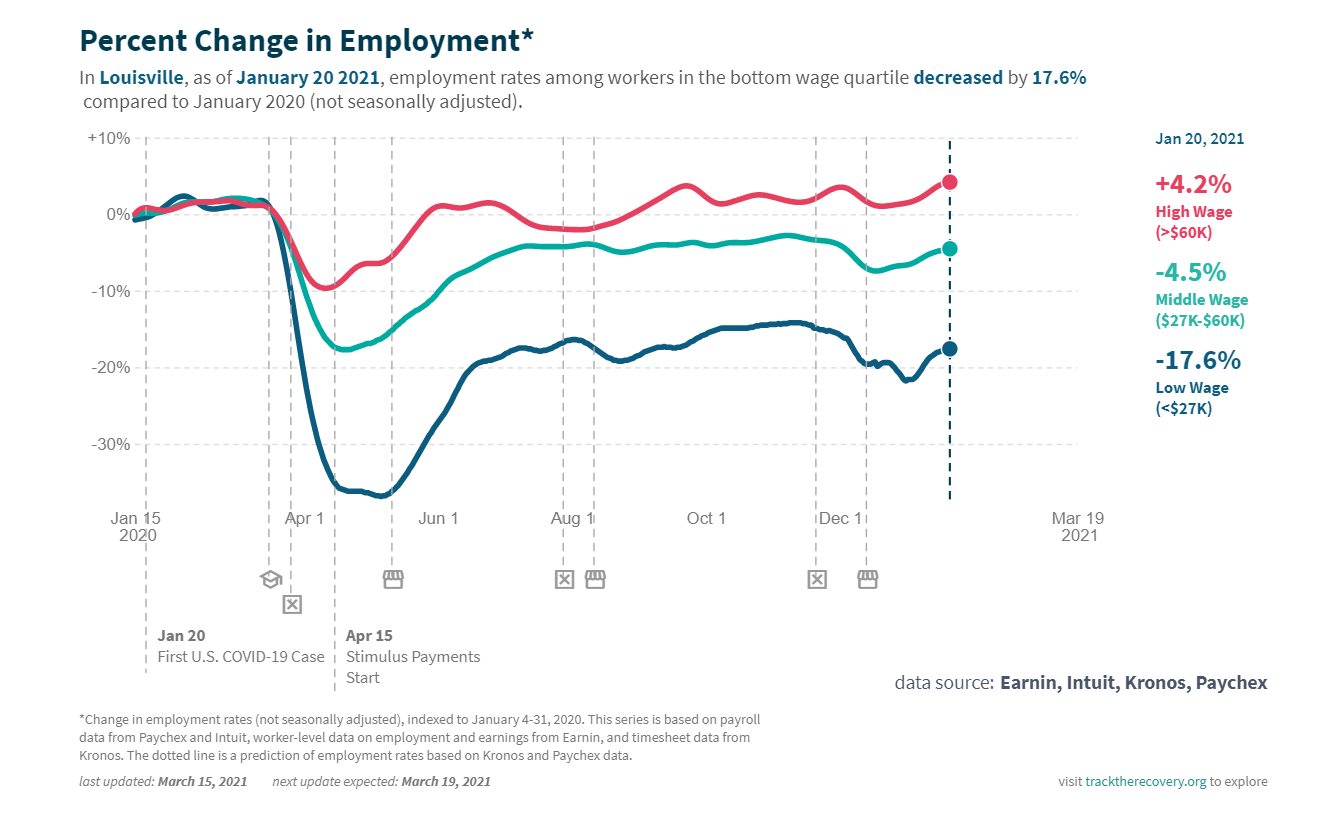2020 Data Review: An uneven economic recovery for the Louisville region
The economic fallout of the COVID-19 pandemic has reverberated throughout the world. The Louisville region’s economy has also suffered as people and businesses reacted to the public health crisis. In this post, we review the data from throughout 2020 to see the economic impact in the local economy. The recovery since the depths of the pandemic has been uneven across sectors and unequal for different workers.
After facing steep job losses in March and April as non-essential businesses closed, payrolled employment bounced back throughout the remainder of 2020. From May to December, the region regained 62% of the jobs lost in March and April. However, there were still 40,000 fewer jobs in the local economy in December as compared to February. This gap left to fill is larger than the job loss experienced during the Great Recession, and leaves us at an employment level last seen in 2015.
Most sectors experienced a decline in average employment levels in 2020 as compared to 2019. The unprecedented demand for e-commerce throughout the pandemic led to an increase in employment levels in the transportation, warehousing, and utilities sector in 2020. The financial activities sector, which includes insurance companies, also saw an increase in employment levels. Average employment levels in the remaining sectors declined in 2020. The leisure and hospitality sector was the hardest hit, as consumers limited their in-person contact and business and leisure travel came to a halt. This sector alone accounts for 39% of the region’s job losses, with 15,200 fewer jobs in 2020 as compared to 2019.
Workers have also faced an uneven recovery during the pandemic. The recession has all but ended for high-wage workers, whose local employment levels have recovered beyond their levels from January. On the other hand, local employment levels for low-wage workers are still down 18%.
Across racial groups, women have experienced steeper employment declines than men, but Black and Latina women have fared the worst. Women have borne the brunt of additional childcare responsibilities during the pandemic, leading to declines in labor force participation. Women of color are also more likely to be working in the service jobs that have seen the largest job losses.
The rollout of vaccines and federal stimulus have brought a sunnier outlook for economic conditions in the months ahead. But many of the changes brought on by the pandemic are unlikely to completely revert to the way things were before. Consumer shifts to online shopping, more remote work and less business travel, and a more technologically advanced workplace are all likely to continue at some level even after the pandemic has passed. These trends have big implications for those still out of work and the workforce as a whole. The McKinsey Institute estimates that 10% of the U.S. workforce, more than 17 million workers, will need to transition to a new occupation or sector, and that these transitions will require workers to have more advanced skills.
The Workforce Innovation and Opportunity Act (WIOA) is the primary funding stream for the U.S. workforce system to provide employment services such as career counseling, job training, and direct referrals to employers. Real investment in WIOA has been declining for decades, falling 42% over the last 20 years. A full and quick economic recovery will require an investment in the workforce system to provide career services and training to displaced workers.





